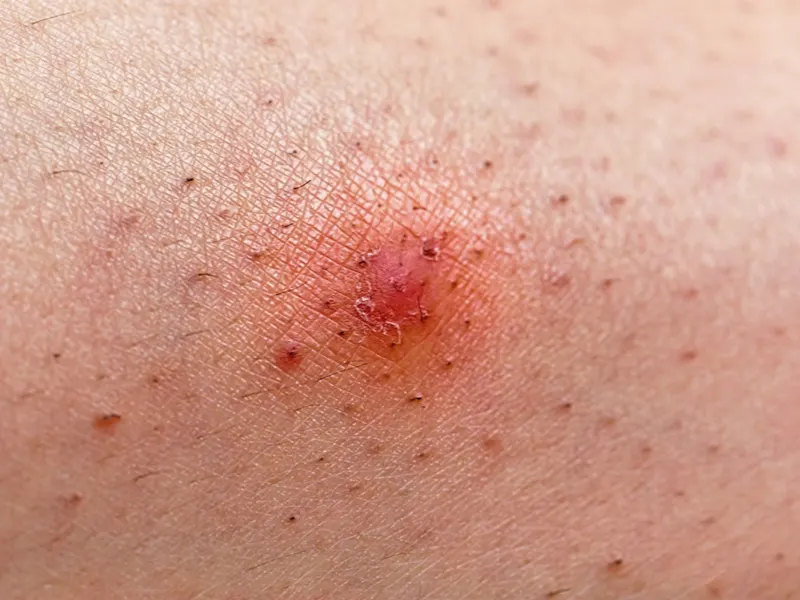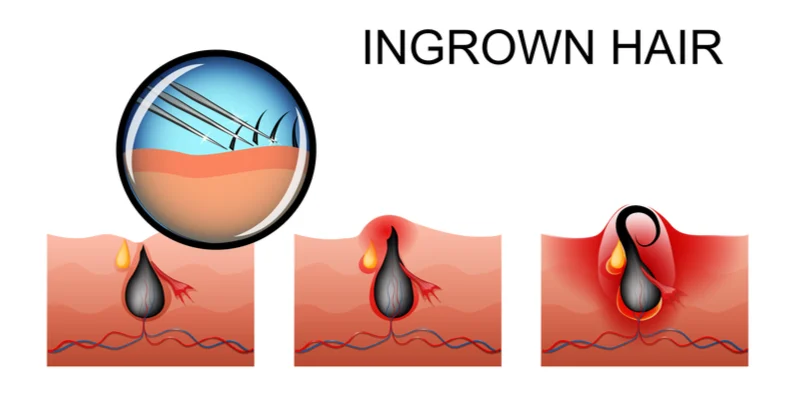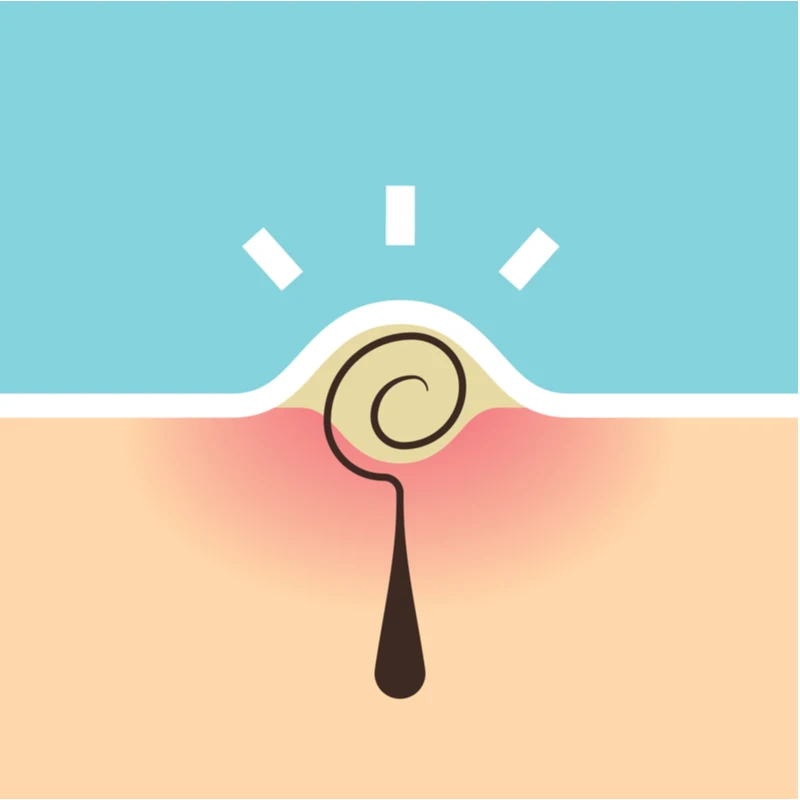Jump to:
Everyone will experience ingrown hair at some point in their lives. While normal, it’s best to remove ingrown hairs when you notice them to avoid complications. Learn how to remove an ingrown hair for the next time you get one in the information below!
How Do You Remove an Ingrown Hair?

I like to take pictures/Shutterstock
Generally, ingrown hairs are harmless. Ingrown hairs are simply hairs that have grown back into the skin. However, when the hair grows back into the skin, an inflamed, red bump develops that is sometimes itchy or tender.
Sometimes, ingrown hair becomes infected. When this happens, a painful red sore or pimple develops. It’s best to remove ingrown hair as quickly as possible to avoid infection.
Now, you’re probably wondering, how exactly do you remove an ingrown hair safely?
The Short Answer
- Properly clean the area of the ingrown hair
- Apply a warm compress to the ingrown hair
- Sterilize your removal tools
- Clean the area again
- Take steps to avoid ingrown hairs: exfoliation
- Take steps to avoid ingrown hairs: dry brushes
- Take steps to avoid ingrown hairs: proper shaving
The Long Answer

Artemida-psy/Shutterstock
The technical term for ingrown hair is pseudofolliculitis. An ingrown hair consists of hair that curls and penetrates the skin with its tip. When this happens, the skin and follicle become inflamed.
People with curly hair are more prone to developing ingrown hairs than those with other hair types. Most ingrown hairs on men develop on the face where they shave, and for women, they most often occur on the bikini line.
However, it isn’t uncommon for women to get them on their armpits or legs as well. Even men and women who do not shave their legs can develop ingrown hairs on their legs. Anyone who removes hair on their body will get the occasional ingrown hair.
Unfortunately, ingrown hairs come with the territory of hair removal. The key to managing ingrown hairs has to do with reducing swelling of the area, keeping the area clean, and making sure you have tools that are clean before removal.
Whatever you do, do not try to pick an ingrown hair out that is deeply embedded under the skin as this will often lead to infection.
It may also encourage the hair to burrow even deeper into the skin. This leads to a much longer healing process. Additionally, the best way to treat ingrown hairs is to avoid them in the first place. We will go over that shortly.
How to Remove an Ingrown Hair in 7 Steps
In your ingrown hair removal process, every step requires cleanliness. Clean skin, clean tools, and clean skin after removal are necessary. So, how should you properly remove ingrown hair? Read on for a 7 step process of ingrown hair removal!
Clean the Area of the Ingrown Hair
First, gently wash the area of the ingrown hair using mild soap and warm water. Make sure the water is not too hot or cold and that the soap is unscented to avoid irritation. If the ingrown hair is not yet irritated, you may exfoliate the area.
Dirt, oils, and dead skin cells infiltrate hair follicles and encourage ingrown hair development. Removing irritants helps to treat ingrown hairs. Sometimes, if exfoliated gently enough, the hair may pull outside of the skin and grow properly.
Apply a Warm Compress to the Ingrown Hair
Applying a warm compress is necessary for ingrown hair removal, especially if the area is irritated. Apply a warm, wet compress such as a warm washcloth to the area and gently press down.
A warm compress will reduce swelling and irritation. Additionally, warm compresses allow the hair follicle to open up and drain the ingrown hair.
Sterilize Your Needle or Tweezers
Make sure all your tools get properly sterilized. If not, you will almost certainly develop an infection. After sterilization, gently work out the ingrown hair. Do not force the hair to come out. Remember, if it is already deeply embedded into your skin, leave it alone and contact a doctor.
This way, you avoid infection. Usually, gently tugging a typical ingrown hair will be enough to remove it. Needing a doctor for further help isn’t often necessary as long as you follow these steps.
When the entirety of the ingrown hair appears on the surface of the skin after gently encouraging the hair to come out, use the tweezers to grab the hair at its base. Then, pull upward to remove the hair. If you attempt to remove only a partially extracted hair, it may remain stuck.
Clean the Area Around the Ingrown Hair Again
After you finish removing the ingrown hair, clean the area again! Use the same, mild soap to clean the skin around where the ingrown hair was. Apply a warm, soapy washcloth as well to prevent any swelling or irritation of the skin.
If the area is not properly cleaned, you risk developing a very serious infection. One of the most common and serious infections known to infiltrate ingrown hairs is Staphylococcus (staph).
Staph normally lives on your skin, and will not cause an infection unless it enters into open skin. Ingrown hairs are breeding grounds for a staph infection, and sometimes staph can be quite serious.
Take Steps to Avoid Future Ingrown Hairs: Exfoliation
This last step is a biggy. The best way to remove ingrown hairs is to prevent their development before they come about! Remember the exfoliation step of cleaning the ingrown hair? Exfoliation is also a great way to prevent ingrown hairs.
Exfoliation gently scrapes away dead skin cells and dirt that naturally accumulates on top of a person’s skin. The layer of dead skin cells and dirt often trap new hairs inside follicles, causing them to grow inside of the skin rather than properly outside of the skin.
One way to use exfoliation to prevent ingrown hairs is to exfoliate before shaving the area. For example, if you frequently shave your legs, scrub your legs with an exfoliating body wash, loofah, or sponge. Items made for exfoliating remove dirt and unclog pores.
Take Steps to Avoid Future Ingrown Hairs: Use a Dry Brush
According to the Cleveland Clinic, dry brushes are an effective way to clean and rejuvenate skin. More specifically, dry brushes are great for removing dead skin cells. To use a dry brush, brush the skin with a firm, long bristled brush.
Do so in a circular motion on the skin where you plan on shaving. The circular motion gently scrapes away dead skin cells, offering softer skin upon removal. Removing dead skin cells encourages clean pores and follicles. This prevents hairs from growing back under the skin.
Take Steps to Avoid Future Ingrown Hairs: Properly Shaving
To avoid developing ingrown hairs, one must shave properly by using gentle shaving cream, quality razors, and shaving in the right direction. So, what does all of this look like?
Quality shaving cream will encourage moisture and reduce friction on the skin. When there is too much friction, the skin becomes irritated and inflamed. This condition is more commonly known as razor burn.
Additionally, shaving cream that uses a lot of chemicals and scents will irritate the skin even more. Poor quality shaving cream creates a breeding ground for ingrown hairs to develop. Ingrown hairs may also indicate that the person shaving is not using the proper razor for their skin.
A good razor and quality shaving cream will move effortlessly on the skin, removing all hairs in their tracks. Razors that do not effectively shave will leave hairs behind and pull hairs.
Additionally, change out your razor regularly to avoid infection and friction on the skin. An old or low-quality razor will lead to cuts, which can lead to infection and ingrown hairs. Lastly, make sure you shave in the right direction.
Whichever part of the body you shave, the hair in the area will grow in the same direction. Shaving in the opposite direction of how the hair grows will cause the hairs to become sharp and possibly pierce the skin and grow inward.
Frequently Asked Questions

Meri Ada/Shutterstock
Check out the most common questions about ingrown hairs below!
Where do people most commonly get ingrown hairs?
People most commonly get ingrown hairs in the areas they shave or wax hairs. For women, this is the bikini line, legs, groin, or armpits. For men, ingrown hairs often appear on the face unless they shave other parts of their bodies.
Is there a risk in removing ingrown hair by yourself?
Yes, even like popping acne, there is a risk in removing ingrown hairs by yourself. If done incorrectly, your skin may become infected or scarred. In fact, doctors often suggest that individuals avoid removing ingrown hairs, especially since they often clear up on their own.
Why do I keep getting ingrown hairs?
You may keep getting ingrown hairs because you have curly or coarse hair. People with curly and coarse hair develop ingrown hairs more often than others. Additionally, you may not be properly shaving and removing your hair.
Do I need to go to the doctor for ingrown hairs?
Sometimes, ingrown hairs will go away on their own or individuals will take the time to remove ingrown hairs by themselves.
However, if you notice that the ingrown hair becomes incredibly swollen, filled with pus, hot to the touch, or very painful, you should go to the emergency room as a serious infection may have taken place.
If you keep getting ingrown hairs and they are purely an annoyance, you may make an appointment with a dermatologist.
What causes ingrown hairs?
Coarse hair and hair removal cause ingrown hairs. Additionally, using razors to shave rather than waxing increases the risk of ingrown hairs. Shaving improperly causes hairs to have sharp edges that often pierce through the skin and become ingrown.
So, How Do You Remove an Ingrown Hair?
In short, you may remove ingrown hair by keeping the area clean and using sterilized tools! Remember to use a warm compress to reduce inflammation as well.
If your ingrown hair becomes warm to the touch or painful, go to an ER and have them remove the ingrown hair for you as serious infection may be present. If you can wait, go to the dermatologist so they can guide you on how to handle your ingrown hairs.
Additionally, you may be able to avoid ingrown hairs or decrease the likelihood that they will develop by removing your hair properly. Start waxing your hair instead, or cease shaving altogether.
If you must shave, make sure you use fragrance and chemical-free shaving creams or gels, and a high-quality, clean razor. Pay attention to which way your hair grows in the area as well so you can shave in the proper direction.
